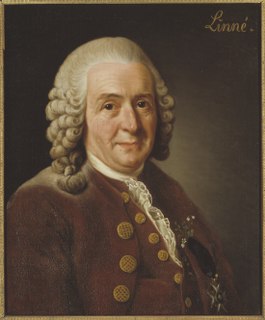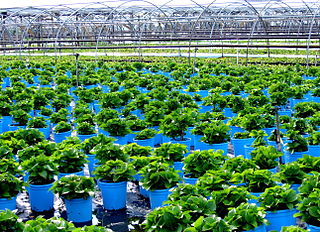
Spider silk is a protein fibre spun by spiders. Spiders use their silk to make webs or other structures, which function as sticky nets to catch other animals, or as nests or cocoons to protect their offspring, or to wrap up prey. They can also use their silk to suspend themselves, to float through the air, or to glide away from predators. Most spiders vary the thickness and stickiness of their silk for different uses.

Orb-weaver spiders or araneids are members of the spider family Araneidae. They are the most common group of builders of spiral wheel-shaped webs often found in gardens, fields and forests. "Orb" was previously used in English to mean "circular", hence the English name of the group. Araneids have eight similar eyes, hairy or spiny legs, and no stridulating organs.

Austracantha is a genus of spider with a single species, Austracantha minax, commonly known as the jewel spider or the Christmas spider. It is a member of the family Araneidae and is endemic to Australia. They are relatively small spiders, reaching a maximum total body length of only around 12 mm (0.47 in) for females, and 5 mm (0.20 in) for males. Their abdomen has six distinctive projections ("spines") that makes them easy to identify. They are predominantly a shiny black, with variable white, yellow, and orange patterns. Melanistic forms also occur during autumn. They are facultatively gregarious, and can be found in large aggregations of overlapping orb webs. They feed on small flying insects that get entangled in their webs. They are harmless to humans, though the webs can be a nuisance for bushwalkers. They are most abundant during the summer months.

The golden silk orb-weavers (Nephila) are a genus of araneomorph spiders noted for the impressive webs they weave. Nephila consists of numerous species found in warmer regions around the world. They are also commonly called golden orb-weavers, giant wood spiders, or banana spiders.
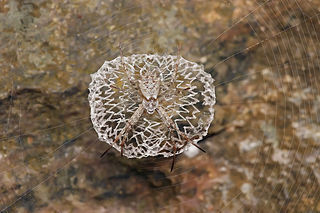
A web decoration or stabilimentum is a conspicuous silk structure included in the webs of some species of orb-web spider. Its function is a subject of debate.
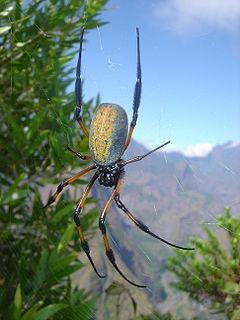
Nephila inaurata, commonly known as the red-legged golden orb-weaver spider or red-legged nephila, is a species of golden orb-weaver spider. It is native to southern and East Africa, besides several islands of the western Indian Ocean.

Nephila clavata, also known as the Jorō spider, is a member of the golden orb-web spider genus. The spider can be found throughout Japan except Hokkaidō, in Korea, Taiwan, China, and more recently, Northeast Georgia in North America. Due to the large size as well as the bright, unique colors of the female Nephila, the spider is well-favored in Japan.

Latrodectus hesperus, the western black widow spider or western widow, is a venomous spider species found in western regions of North America. The female's body is 14–16 mm in length and is black, often with an hourglass-shaped red mark on the lower abdomen. This "hourglass" mark can be yellow, and on rare occasions, white. The male of the species is around half this length and generally a tan color with lighter striping on the abdomen. The population was previously described as a subspecies of Latrodectus mactans and it is closely related to the northern species Latrodectus variolus. The species, as with others of the genus, build irregular or "messy" webs: Unlike the spiral webs or the tunnel-shaped webs of other spiders, the strands of a Latrodectus web have no apparent organization.

The spider species Argiope aurantia is commonly known as the yellow garden spider, black and yellow garden spider, golden garden spider, writing spider, zigzag spider,corn spider, or McKinley spider. It is common to the contiguous United States, Hawaii, southern Canada, Mexico, and Central America. It has distinctive yellow and black markings on the abdomen and a mostly white cephalothorax. Its scientific Latin name translates to "gilded silver-face". Males range from 5–9 mm (0.20–0.35 in); females range from 19–28 mm (0.75–1.10 in). These spiders may bite if disturbed or harassed, but the venom is harmless to non-allergic humans, roughly equivalent to a bumblebee sting in intensity.

Nephilinae is a spider subfamily of the family Araneidae with five genera. The various genera in Nephilinae were formerly grouped in the family Nephilidae, and before that in the Tetragnathidae and in the Araneidae. All nephiline genera partially renew their webs.

Nephila edulis is a species of large spider of the Araneidae family. It is referred to the common name Australian golden orb weaver. It is found in Australia, in both tropical and temperate regions, and in parts of New Guinea and New Caledonia.

Nephila pilipes is a species of golden orb-web spider. It can be found in Japan, China, Vietnam, Cambodia, Taiwan, Malaysia, Singapore, Myanmar, Indonesia, Thailand, Laos, Philippines, Sri Lanka, India, Nepal, Papua New Guinea, and Australia. It is commonly found in primary and secondary forests and gardens. Females are large and grow to a body size of 30–50 mm, with males growing to 5–6 mm. It is the largest of the orb-weaving spiders apart from the recently discovered Nephila komaci, and one of the biggest spiders in the world.
Nephilengys is a genus of tropical spiders of the family Araneidae, consisting of two currently described species. The genus Nephilingis has been split off from this genus. Both genera have been called hermit spiders from the habit staying in their retreats during the day; the name eunuch spiders has been used for Nephilengys alone. Males may sever parts of their palpal bulbs after copulation.

Sexual cannibalism is when a female cannibalizes her mate prior to, during, or after copulation. It is a phenomenon characterized primarily by members of most arachnid orders, as well as several insect orders. The adaptive foraging hypothesis, aggressive spillover hypothesis and mistaken identity hypothesis are among the proposed hypotheses to explain how sexual cannibalism evolved. This behavior is believed to have evolved as a manifestation of sexual conflict, occurring when the reproductive interests of males and females differ. In many species that exhibit sexual cannibalism, the female consumes the male upon detection. Females of cannibalistic species are generally hostile and unwilling to mate; thus many males of these species have developed adaptive behaviors to counteract female aggression.
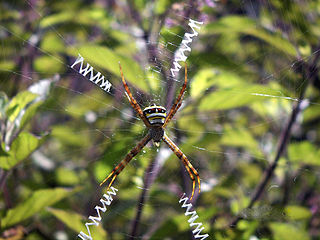
Argiope anasuja, is a species of harmless orb-weaver spider found from the Seychelles to India, Pakistan and Sri Lanka, and in the Maldives.
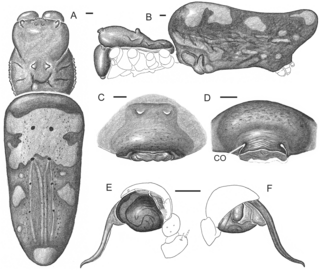
Nephila komaci is a species of golden orb-web spider. It is the largest web-spinning spider known. A few specimens have been found in South Africa and Madagascar.
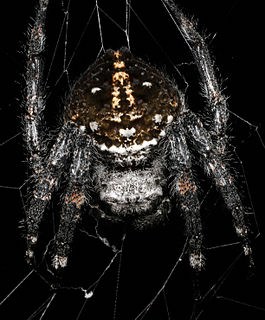
Darwin's bark spider is an orb-weaver spider that produces the largest known orb webs, ranging from 900 to 28,000 square centimetres, with bridge lines spanning up to 25 metres (82 ft). The spider was discovered in Madagascar in the Andasibe-Mantadia National Park in 2009. Its silk is the toughest biological material ever studied, over ten times tougher than a similarly-sized piece of Kevlar. The species was named in honour of the naturalist Charles Darwin, with the description being prepared precisely 150 years after the publication of The Origin of Species, on 24 November 2009.
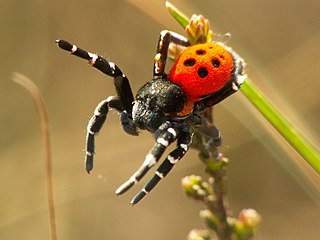
Sexual selection in spiders shows how sexual selection explains the evolution of phenotypic traits in spiders. Male spiders have many complex courtship rituals and have to avoid being eaten by the females, with the males of most species survive a few matings, and having short life spans.
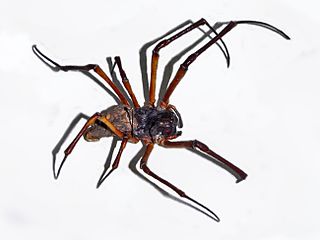
Nephila sumptuosa, the red-legged golden orb-web spider, is a species of golden orb-web spider.






